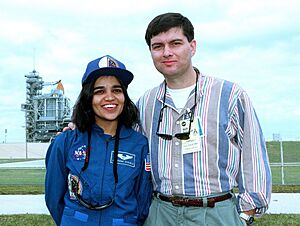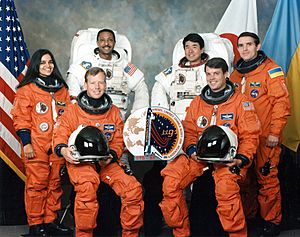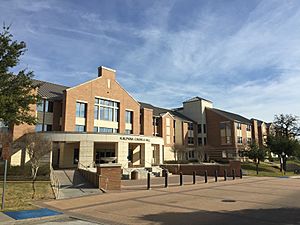Kalpana Chawla facts for kids
Quick facts for kids
Kalpana Chawla
|
|
|---|---|
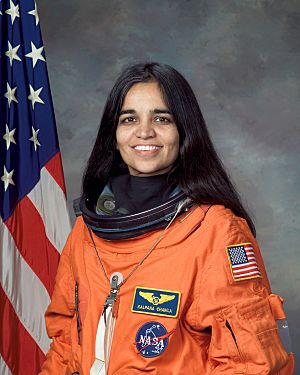 |
|
| Born | March 17, 1962 Karnal, Haryana, India
|
| Died | February 1, 2003 (aged 40) Over Texas, U.S
|
| Resting place | Zion National Park, Utah, U.S. |
| Awards |
|
| Space career | |
| NASA astronaut | |
|
Time in space
|
31d 14h 54m |
| Selection | NASA Group 15 (1994) |
| Missions | STS-87 STS-107 |
|
Mission insignia
|
|
Kalpana Chawla (March 17, 1962 – February 1, 2003) was a brave Indian-American astronaut and aerospace engineer. She made history as the first woman of Indian origin to travel to space. From a young age, Kalpana was fascinated by airplanes and the sky.
She followed her dream by studying engineering in India and later in the United States. In the early 1990s, she became a U.S. citizen, which allowed her to apply to become a NASA astronaut.
Her first spaceflight was in 1997 aboard the Space Shuttle Columbia. She worked as a mission specialist and operated the shuttle's robotic arm. Her second and final mission was also on Columbia in 2003. Tragically, the shuttle broke apart as it was returning to Earth. Kalpana and the six other crew members on board did not survive the accident.
For her courage and contributions, Kalpana Chawla was honored with many awards after her death, including the Congressional Space Medal of Honor. She continues to be an inspiration to people all over the world.
Contents
A Dream of Flying
Kalpana Chawla was born on March 17, 1962, in Karnal, India. Her parents were Banarsi Lal Chawla and Sanjogta Kharbanda. As a child, she loved watching airplanes and was curious about flying. While some people thought engineering was not a field for girls, Kalpana was determined to follow her passion. She was a great student and graduated from school near the top of her class in 1976.
Education in India and the U.S.
Kalpana studied aeronautical engineering (the science of designing aircraft) at Punjab Engineering College in India. She was one of only a few women in her program. After earning her first degree in 1982, she knew she wanted to learn even more.
She moved to the United States to continue her studies. She earned a Master's degree from the University of Texas at Arlington in 1984. It was there that she met her husband, Jean-Pierre Harrison. Kalpana then went to the University of Colorado Boulder and earned her PhD in aerospace engineering in 1988. While studying, she also learned to fly different types of airplanes and gliders, becoming a certified pilot and flight instructor.
Working at NASA
In 1988, Kalpana began working at the Ames Research Center, one of NASA's research labs. She used powerful computers to study how air flows around aircraft, especially those that can take off and land in very short distances.
In 1994, her dream of going to space came closer to reality. She was selected by NASA to begin training as an astronaut. She joined the NASA Astronaut Corps and prepared for her first mission.
First Journey to the Stars
On November 19, 1997, Kalpana Chawla launched into space for the first time on the Space Shuttle Columbia mission STS-87. She was the first woman born in India to achieve this. The Prime Minister of India called her in space to congratulate her and tell her how proud the country was.
During the mission, one of her tasks was to deploy the Spartan satellite using the shuttle's robotic arm. However, a problem occurred, and the satellite did not deploy correctly. Another astronaut had to perform a spacewalk to retrieve it. At first, some people in the media blamed Kalpana, but NASA later investigated the incident. They found that the problem was caused by issues with software and ground control communication, and Kalpana was cleared of any error.
She also conducted several science experiments, including studying how to mix liquids and metals in microgravity. These experiments helped scientists understand processes that could be used to make better computer chips on Earth. In total, her first mission lasted over 15 days.
The Final Mission of Columbia
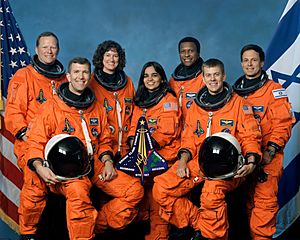
In 2000, Kalpana was selected for her second space mission, STS-107, again on the Space Shuttle Columbia. The mission was dedicated to science and research. The crew worked in two shifts around the clock to perform over 80 different experiments. Kalpana's work included studying how plants grow in space and how fire behaves in microgravity.
The mission launched on January 16, 2003. After 16 successful days in space, the shuttle began its journey back to Earth on February 1, 2003. During re-entry into the Earth's atmosphere, a tragedy occurred. The shuttle broke apart over Texas, and the entire seven-member crew was lost.
An investigation later found the cause of the disaster. During the shuttle's launch, a piece of foam insulation from the external fuel tank broke off and hit the orbiter's left wing. This created a hole that allowed hot gases to enter the wing during re-entry, causing the shuttle to break up.
Kalpana's remains were found and later cremated. They were scattered in Zion National Park in Utah, a place she loved.
An Enduring Inspiration
Kalpana Chawla's life and career have inspired millions of people, especially young women interested in science and space. After her death, she was honored in many ways around the world.
- The Prime Minister of India renamed a weather satellite Kalpana-1 in her honor.
- An asteroid was named 51826 Kalpanachawla.
- Seven hills on the planet Mars were named after the Columbia crew, with one called Chawla Hill.
- She was posthumously awarded the Congressional Space Medal of Honor, one of the highest awards for an astronaut.
- The University of Texas at Arlington named a residence hall Kalpana Chawla Hall.
- In 2020, a Northrop Grumman spacecraft that carried supplies to the International Space Station was named the S.S. Kalpana Chawla.
Her story shows that with hard work and determination, it is possible to achieve great dreams.
Kalpana Chawla quotes
- "I would say if you have a dream, follow it."
- "You are your intelligence."
- "The path from dreams to success does exist. May you have the vision to find it, the courage to get on it and the perseverance to follow it."*"There are so many people who are arguing or fighting over issues which don’t have much relevance. We must all realise it is not worth it."
- "Take the time to figure out how to get there. The quickest way may not necessarily be the best. The journey matters as much as the goal."
See also
 In Spanish: Kalpana Chawla para niños
In Spanish: Kalpana Chawla para niños


